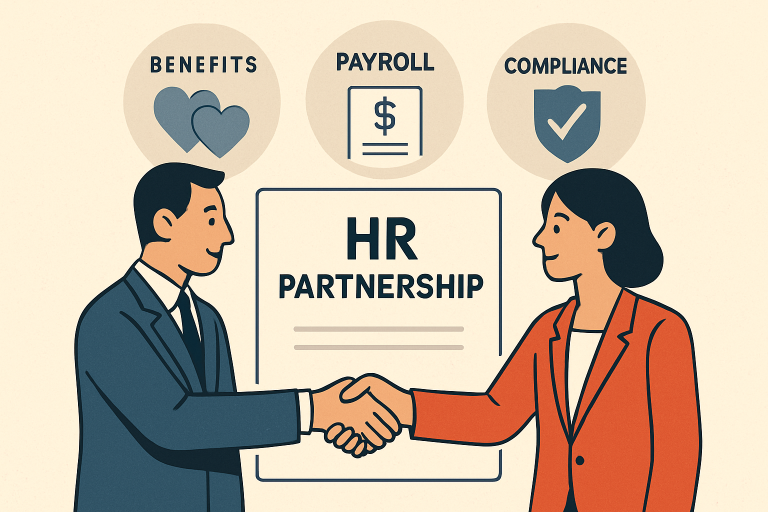Evaluating the Pros and Cons of Partnering with a Professional Employer Organization (PEO)
Table of Contents
- Introduction
- What is a PEO
- Advantages of Using a PEO
- Disadvantages of Using a PEO
- Is a PEO Right for Your Business
- Conclusion
Introduction
Businesses of all sizes recognize the significant challenges that come with managing human resources. The landscape is marked by numerous regulatory hurdles, time-consuming administrative tasks, and a constant demand to attract and retain top talent. Because of these complexities, many companies weigh the merits of working with a Professional Employer Organization (PEO). Before making this crucial decision, it’s essential to understand both the advantages and drawbacks of partnering with a PEO, particularly when compared to more traditional HR solutions, such as hiring an in-house manager. To help clarify the debate, explore this guide on PEO vs hiring HR manager pros and cons.
In this article, we break down what a PEO is, examine its potential to transform your HR functions, and explore whether this partnership is the right fit for your business. We also provide an objective look at the practical realities companies face when they outsource HR to a third party.
What Is a PEO?
A Professional Employer Organization is an external partner that assumes a co-employment relationship with your workforce. This partnership enables the PEO to manage core employee responsibilities, including payroll administration, benefits, regulatory compliance, and risk management. Through this co-employment model, businesses can leverage the knowledge and infrastructure of the PEO while maintaining control over day-to-day operations and workplace culture.
PEOs are especially appealing for small and medium-sized businesses that want access to better benefits and HR expertise without the costs and complexities of building an in-house HR team. According to the ADP, PEOs serve more than 173,000 small and mid-sized businesses in the U.S. alone, reflecting a rapidly rising trend in HR outsourcing.

Advantages of Using a PEO
Access to Competitive Employee Benefits
A major advantage of partnering with a PEO is access to employee benefits packages that rival those of much larger organizations. Grouping hundreds or thousands of employees together enables PEOs to negotiate better rates and terms with insurance providers, often resulting in high-quality health, dental, vision, and retirement plans for employees. This can significantly enhance your company’s appeal in the competitive hiring market by offering perks that are typically out of reach for smaller employers.
Reduced Administrative Burden
Handling payroll, benefits administration, onboarding, and compliance filings can overwhelm any HR department. By outsourcing these critical but non-core tasks, a business can redirect valuable internal resources and leadership energy toward strategic initiatives. PEOs streamline paperwork, automate payroll processing, and ensure taxes are paid accurately and on time, freeing up internal staff to focus on growth and innovation.
Enhanced Compliance and Risk Management
Labor laws change frequently at the federal, state, and local levels, creating a maze of regulations that businesses must navigate. PEOs bring deep expertise in compliance, tracking legal changes, and helping clients avoid the costly pitfalls of non-compliance, such as fines, penalties, and lawsuits. With a PEO, you can benefit from risk management specialists who routinely update policy and procedure templates and provide guidance on a broad range of workforce issues.
Disadvantages of Using a PEO
Loss of Control Over HR Functions
One of the challenges with the PEO model is surrendering some direct control over HR processes. Standardized procedures across a PEO’s client base can limit the degree of customization available for your company’s handbook, policies, or payroll cycles. For organizations with a distinct culture or niche operational needs, this lack of flexibility could impact morale or efficiency.
Potential for Hidden Costs
Although PEOs often promise economies of scale, their services also carry fees that may not always be clear up front. The pricing can be based on percentages of payroll, flat fees per employee, or bundled services that may not fit every client’s needs. Companies should carefully review contracts, pay attention to auxiliary charges, and weigh benefits against the financial commitment. Guidance from resources like Business.com can help businesses navigate these conversations and spot hidden expenses.
Employee Adjustment Period
Adopting a PEO can require your workforce to get used to new systems and policies. This transition can sometimes cause confusion, delays, or apprehension among employees, particularly when communication is not handled proactively. HR system changes and new protocols often necessitate extra training and a period of adjustment before the benefits of the partnership are fully realized.
Is a PEO Right for Your Business?
There’s no one-size-fits-all answer. The decision to partner with a PEO depends on your company’s size, strategic direction, growth aspirations, and available internal HR talent. A thorough cost-benefit analysis, including both tangible and intangible pros and cons, should be performed. Companies seeking to scale rapidly, enter new markets, or enhance compliance may find a PEO partnership ideal. At the same time, firms that prioritize hands-on control or highly customized HR policies may prefer an internal HR team.
Engage your leadership group, assess your current HR pain points, and consult with trusted financial and legal advisors before committing to any HR outsourcing arrangement.
Conclusion
Partnering with a Professional Employer Organization offers clear benefits, including greater access to competitive benefits, a reduced administrative burden, and enhanced compliance. Yet, these advantages must be considered alongside possible downsides, including less direct HR control, hidden costs, and the disruption of transitional periods. Dedicating time to a balanced and thoughtful evaluation ensures that your HR solution aligns perfectly with your business goals and workplace culture.

